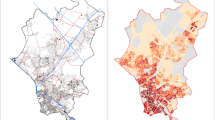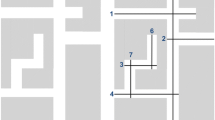Abstract
Walking distances to metro stations vary substantially across systems, lines and stations, but few studies have attempted to explain such variable performance. The present study examines commercial land use, intersection density, total road length, distance to the nearest metro station, theoretical catchment area and built form density (FAR) as factors to explain walking distance in a study of 14 metro stations with 43 exits in three cities. These factors explain 7.5% of the variance in walking distance, amounting to a 16% difference in territorial coverage of the station, based on Euclidean extrapolation. In addition, stations with higher levels of patronage tend to have longer walks. Walking distance can be partially explained by the presence of commerce, while intersection density is negatively related to walking distance, in contrast to some indications in the literature. Commercial land use and certain employment areas have a much higher rate of destinations than do residential areas overall. The planning standard for pedestrian catchment zones and FAR are not significant in walking distance, although both are heavily relied upon for planning metros. This study reveals that land use and urban design can be controlled to promote the local use of metro.

Similar content being viewed by others
Explore related subjects
Discover the latest articles, news and stories from top researchers in related subjects.Notes
Calculated as the total floor area of the buildings as calculated for zoning purposes, divided by the area of the legal land plot.
References
Badland H, Schofield G (2005) Transport, urban design and physical activity: an evidence-based update. Transp Res Part D: Transp Environ 10(3):177–196
Cervero R, Kockelman K (1997) Travel demand and the three Ds: density, diversity and design. Transp Res Part D Transp Environ 2(3):199–219
Cervero R, Sarmiento OL, Jacoby E, Gomez LF, Neiman A (2009) Influences of built environments on walking and cycling: lessons from Bogotà. Int J Sustain Transp 3:203–226
Ewing R, Handy SL, Brownson, R, Clemente O (2006) Identifying and measuring urban design qualities related to walkability. In: proc. transportation research board ann. meet., January 2006 Washington, DC, USA
Flyvbjerg B, Hohm M, Buhl S (2005) How (in)accurate are demand forecasts in public works projects? The case of transportation. J Am Plan Assoc 71(2):131–146
Forsyth A, Oakes JM, Schmitz KH, Hearst M (2007) Does residential density increase walking and other physical activity? Urban Stud 44(4):679–697
Gutiérrez J, García-Palomares JC (2008) Distance-measure impacts on the calculation of transport service areas using GIS. Environ Plan B Plan Des 35:480–503
Handy S (2006) Questioning assumptions: do new urbanists walk more? Planning 72(1):36–37
Hensher DA, Rose JM, Collins AT (2011) Identifying commuter preferences for existing modes and a proposed Metro in Sydney, Australia with special reference to crowding. Public Transp 3:109–147
Hsiao S, Lu J, Sterling J, Weatherford M (1997) Use of geographic information system for analysis of transit pedestrian access. Transp Res Rec 1604:50–59
Hsu C-I, Tsai Y-C (2014) An energy expenditure approach for estimating walking distance. Environ Plan B Plan Des 41:289–306
Idris AO, Habib KMN, Shalaty A (2015) An investigation on the performance of mode shift models in transit ridership forecasting. Transp Res Part A Policy Pract 78:551–565
Jiang Y, Zegras D, Mehndiratta S (2012) Walk the line: station context, corridor type and bus rapid transit walk access in Jinan, China. J Transp Geogr 20:1–14
Ker I, Ginn S (2003) Myths and realities in walkable catchments: the case of walking and transit. In: proceedings of the 21st ARRB and 11th REAAA conference. Transport. Our highway to a sustainable future, p 16
Kim KW, Lee DW, Chun YH (2010) Comparative study on the service coverages of subways and buses. KSCE J Civ Eng 14(6):915–922
Kitamura R, Mokhtarian PL, Laidet L (1997) A micro-analysis of land use and travel in five neighborhoods in the San Francisco Bay Area. Transportation 24:125–158
Koohsari MJ, Badland H, Giles-Corti B (2013) (Re) Designing the built environment to support physical activity: bringing public health back into urban design and planning. Cities 35:294–298
Kuby M, Barranda A, Upchurch C (2004) Factors influencing light-rail boardings in the United States. Transp Res Part A 38:223–247
Li S, Zhao P (2017) Exploring car ownership and car use in neighborhoods near metro stations in Beijing: does the neighborhood built environment matter? Transp Res Part D Transp Environ 56:1–17
Liu R, Pendyala RM, Polzin SE (1998) A simulation of the effects of intermodal transfer penalties on transit use. Transp Res Rec 1623:88–95
Loo BPY, Chan TH (2007) West rail and modal hierarchy in Hong Kong: some preliminary findings. In: the 12th conference of the Hong Kong Society for Transportation Studies, Hong Kong, 8–10 December
Loutzenheiser DR (1997) Pedestrian access to transit: model of walk trips and their design and urban form determinants around bay area rapid transit stations. Transp Res Rec 1604:40–49
Moniruzzaman MD, Páez A (2012) Accessibility to transit, by transit, and mode share: application of a logistic model with spatial filters. J Transp Geogr 24:198–205
Morral J, Bloger D (1996) The relationship between downtown parking supply and transit use. ITE J 66(2):32–36
O’Sullivan S, Morrall J (1996) Walking distances to and from light-rail transit stations. Transp Res Rec 1538:19–26
Özgür Ö (2011) Performance analysis of rail transit investments in Turkey: istanbul, Ankara, Izmir and Bursa. Transp Policy 18(1):147–155
Papa E, Bertolini L (2015) Accessibility and transit-oriented development in European metropolitan areas. J Transp Geogr 47:70–83
Rastogi R, Rao KV (2003) Defining transit accessibility with environmental inputs. Transp Res Part D Transp Environ 8:383–396
Rodríguez DA, Khattak AJ, Evenson KR (2007) Can new urbanism encourage physical activity? Comparing a new urbanist neighborhood with conventional suburbs. J Am Plan Assoc 72(1):43–54
Saelens BE, Sallis JF, Black JB, Chen D (2003) Neighborhood-based differences in physical activity: an environment scale evaluation. Am J Public Health 93(9):1552–1558
Saghapour T, Moridpour S, Thompson RG (2016) Modeling access to public transport in urban areas. J Adv Transp 50(8):1785–1801
Seneviratne PN (1985) Acceptable walking distances in central areas. J Transp Eng 111(4):365–376
Shoup D (2005) The high cost of free parking. Planners Press, American Planning Association, Chicago
Sisiopiku VP, Akin D (2003) Pedestrian behaviors at and perceptions towards various pedestrian facilities: an examination based on observation and survey data. Transp Res Part F 6:249–274
Sun G, Zacharias J, Ma B, Oreskovic N (2016) Walking from metro: the effect of local built environment in Beijing. Cities 56:91–98
Sun G, Webster C, Chiaradia A (2017) Ungating the city: a permeability perspective. Urban Stud. https://doi.org/10.1177/0042098017733943
Sung H, Oh J-T (2011) Transit-oriented development in a high-density city: identifying its association with transit ridership in Seoul, Korea. Cities 28:70–82
Taylor BD, Fink CNY (2013) Explaining transit ridership: what has the evidence shown? Transp Lett Int J Transp Res 5(1):15–26
Townsend C, Zacharias J (2010) Built environment and pedestrian behavior at rail rapid transit stations in Bangkok. Transportation 37:317–330
Union Internationale des Transports Publics UITP (2016) Statistics brief world metro figures (pdf). http://www.uitp.org. Accessed 21 Nov 2016
Upchurch C, Kuby M (2014) Evaluating light rail sketch planning: actual versus predicted station boardings in Phoenix. Transportation 41(1):173–192
Upchurch C, Kuby M, Zoldak M, Barranda A (2004) Using GIS to generate mutually exclusive service areas linking travel on and off a network. J Transp Geogr 12:23–33
Zacharias J (2006) Exploratory behaviour in real and virtual environments. Landsc Urban Plan 78:1–13
Zacharias J, Bai Z, Han X, Huang Y (2017) Local environment and social factors in primary school children’s afterschool commute in China. Prev Med Rep 7:206–210
Author information
Authors and Affiliations
Corresponding author
Rights and permissions
About this article
Cite this article
Zacharias, J., Zhao, Q. Local environmental factors in walking distance at metro stations. Public Transp 10, 91–106 (2018). https://doi.org/10.1007/s12469-017-0174-y
Accepted:
Published:
Issue Date:
DOI: https://doi.org/10.1007/s12469-017-0174-y




